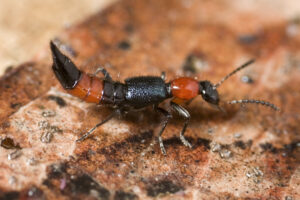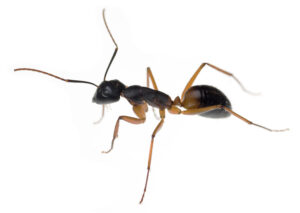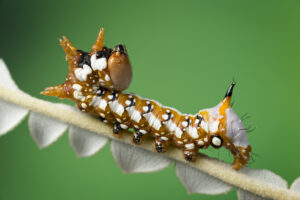Identifying insects
Many insects are instantly recognisable but what do you do when you find an insect you’ve never seen before?
If I described an insect as having a triangular head with large eyes, spindly hind legs and grasping raptorial forelegs, I reckon most of you would have an image of a praying mantis in mind. You would be correct. If I described a different insect as elongated with forceps-like pincers at their rear end, I reckon you would all recognise the insect as an earwig.
What about other insects? How do you tell the difference between a bug and a beetle? What about between a caterpillar and a sawfly larva? Learning the basic differences between the major groups of insects is what we are going to cover in this Pest Files.
By major insect groups I mean insect orders, which are usually given a Latin name that describes their wings. In this Pest Files we will look at the most diverse insect orders i.e., those with the greatest number of species. They are beetles (Coleoptera); ants, bees and wasps (Hymenoptera); moths and butterflies (Lepidoptera); flies, midges and mozzies (Diptera); aphids, bugs, hoppers, whitefly (Hemiptera); and crickets, grasshoppers and katydids (Orthoptera). Perhaps in another Pest Files we can look at some less diverse insect orders.
Let’s start by describing a typical insect. They have three body parts: the head (which contains the sensory organs), the thorax (to which legs and wings are attached), and the abdomen (which contains the vital organs). They have six legs which immediately differentiates them from spiders, mites and millipedes etc. They also have up to two pairs of wings (some only have one pair), one pair of antennae, and mouthparts (usually). Body parts, legs, wings, antennae and mouthparts may vary between insect orders and within insect orders.
Beetles make up the order Coleoptera, a word which translates as ‘sheath wing’ that refers to the hardened forewings of beetles that protect the hindwings (the flight wings). The hardened forewings of beetles are technically known as elytra and they always meet in a straight line in the middle of the back – they do not overlap. This wing arrangement is unique to beetles. Some beetles like rove beetles (Staphylinidae) have shortened elytra, but they still meet in a straight line.

Beetles have chewing mouthparts which are obvious in some beetles such as predatory carabid beetles. Mouthparts are not so obvious in weevils (they are beetles too!) where the mouthparts are at the end of an elongated snout. The shape and length of antennae vary greatly between beetle families. For example, ladybirds (Coccinellidae) usually have short clubbed antennae compared to leaf beetles (Chrysomelidae) which usually have longer thinner antennae.
Beetle larvae are often encountered in gardens, and the most recognisable are ‘curl’ grubs of the family Scarabaeidae. Scarab larvae have six obvious legs and robust mandibles. Larvae from other beetle families may look very different. Weevil larvae (family Curculionidae) are legless and have visible mandibles. Wireworms (the larvae of click beetles – Elateridae), and mealworms and false wireworms (the larvae of beetles in the family Tenebrionidae) are elongated, with shiny toughened bodies and short legs. Compare those to ladybird beetle larvae, which are active larvae with six legs often seen crawling around on plants feeding on aphids.

Ants, bees, sawflies and wasps make up the family Hymenoptera, a word which translates as ‘membrane wing’ that refers to the four membranous wings found on typical hymenopteran insects. Female ants, bees and wasps usually have stings that are modified egg laying structures. Males do not have stings.
Ants are excellent insect models because their three body segments are distinct, as are their six legs, and they have a node between their thorax and abdomen which differentiates them from other hymenopterans. Ants also have distinctive elbowed antennae. Reproductive ants have two pairs of wings, but all worker ants are wingless. As worker ants are all sterile females, that means they usually possess a sting.
Bees are usually quite hairy insects, and female bees mostly have some sort of pollen collecting structure. Bees are usually hairier but less ‘waisted’ than wasps. Ants and wasps have visible chewing mouthparts (mandibles), while bees have combination chewing and lapping mouthparts (put simply – mandibles and a tongue). Wasps are similar in general structure to ants, but most species have two pairs of membranous wings and many species have an accentuated ‘waist’. Not all wasps are your typical ‘hornet’ shaped insect though. Many species of parasitic wasps are tiny (only a millimetre or two long) and may not be as obviously segmented as their larger counterparts.

Sawfly adults usually have a stocky shape compared to bees and wasps and do not have an obvious ‘waist’. Sawflies have chewing mouthparts and females have a saw-like ovipositor (hence their common name), which allows females to cut slots in plant material to lay their eggs in. The larvae of ants, bees and wasps are legless grubs, while sawfly larvae are usually caterpillar-like and have up to eight pairs of prolegs (fleshy growths under the abdomen). Confusingly, some sawfly larvae such as ‘spitfire grubs’ (Pergidae) have no prolegs at all.
Moths and butterflies make up the family Lepidoptera, a word which means ‘scale wing’. This refers to the two pairs of scale covered wings of most lepidopterans. Anyone who has picked up a moth or butterfly will notice the powdery dusty material left on your hand. Most moths and butterflies have a curled proboscis, although some may have reduced mouthparts or no mouthparts at all. Most moths and butterflies have six legs, but in some butterflies the front pair may be greatly reduced and not visible, giving them the appearance of only having four legs.

Butterflies have clubbed antennae and are typically day-flying. Moths tend to fly at night although there are quite a few common day-flying moths (such as grapevine moth Phalaenoides glycinae). Moths have straight or feathery antennae. Usually, but not always, it is male moths that have the feathery antennae. The larvae of moths and butterflies have chewing mouthparts, three pairs of true legs, and up to five pairs of abdominal prolegs (which immediately differentiates them from sawfly larvae).
Flies, midges and mosquitoes make up the order Diptera, a word which means ‘two wings’. This refers to the single pair of wings, the forewings, that flies possess. The hindwings are greatly reduced into small, knobbed structures known as halteres that act as stabilisers during flight. Only dipterans have one pair of wings and a pair of halteres.
Mosquitoes have sucking mouthparts, but other dipterans such as houseflies have sponging mouthparts that require food to be liquified through regurgitation. For a demonstration of that I refer you to the dinner scene in David Cronenberg’s 1986 movie The Fly. The larvae of flies are legless and are commonly referred to as maggots. Mosquito larvae are also legless and are commonly called ‘wrigglers’.
The order Hemiptera is very diverse and contains everything from cicadas, aphids, and leafhoppers, to harlequin bugs. What these insects have in common is sucking mouthparts. The word Hemiptera means ‘half wing’ which certainly describes the wings of the suborder Heteroptera. These are the ‘true bugs’ (such as harlequin bugs) which have forewings with a thickened base and membranous tips. At rest, the wings are partially crossed over each other which differentiates them from beetles. Some heteropterans are plant feeders and some are predatory, and their mouthparts extend from the front of their heads.
The hemipteran suborder Auchenorrhyncha includes cicadas, leafhoppers, and spittlebugs, and their mouthparts extend from the base of their heads. They are all plant feeders and usually have short bristle antennae. The suborder Sternorrhyncha includes aphids, mealybugs, and scale insects, and their mouthparts extend almost as far back as their front legs. They are all plant feeders, and they have long antennae when present.
The last order we will look at are insects in the order Orthoptera; the crickets, grasshoppers and katydids. The word ‘orthoptera’ means ‘straight wings’, which refers to the narrow straight forewings of orthopterans. The forewings are also a bit leathery which protect the much broader, membranous hindwings, the flight wings. Orthopterans all have chewing mouthparts, thin antennae, large compound eyes, and in many species the femurs of their hindlegs are enlarged for jumping.
Female orthopterans tend to have long, robust ovipositors that are easily seen. The antennae of grasshoppers and locusts are short, while the antennae of crickets and katydids tend to be long. Mole crickets (family Gryllotalpidae) are a little different in appearance in that they have six muscular legs, especially the forelegs and hindlegs which are adapted for digging. Orthopteran insects go through a lifecycle of incomplete metamorphosis, which means the nymphs are miniature versions of the adult form but without wings.
If you come across an insect in your garden, crop, nursery etc., you can now have a stab a working out which order of insects it belongs to. If you combine that with other information such as the plant you found it on, what it was doing (feeding on the plant or just wandering around), and the geographical location, you are well on your way to identifying the insect.
There are plenty of online sources to turn to for help:
CSIRO (to confirm the insect group): https://anic.csiro.au/insectfamilies/
WA Pest Web (type PestWeb in the search bar at): https://www.agric.wa.gov.au/
Atlas of Living Australia: https://www.ala.org.au/
or post an image of the insect on iNaturalist: https://inaturalist.ala.org.au/
There are also many field guides in print that are produced by Departments of Agriculture or equivalent around the country, as well as CSIRO. My book, Garden Pests, Diseases & Good Bugs, might also help.
As you can see from the brief descriptions of the main insect orders, insect legs, wings, mouthparts and body shapes differ between groups of insects. Insects also vary in how they behave. When you find an insect new to you, maybe ask yourself what’s it on, what is it doing, what does it look like, what is it similar to? Welcome to my world.
Denis Crawford
Author: Gardens, Pests, Diseases & Good Bugs
M: 0417 117 741
W: youtube.com/c/oneminutebugs
All images supplied by Denis Crawford
Main photo: This caterpillar has three pairs of true legs and four pairs of abdominal prolegs

